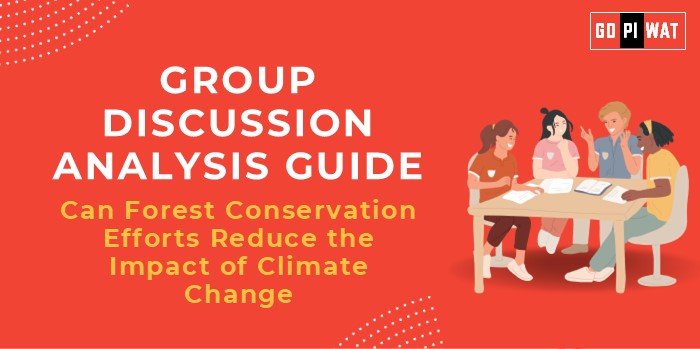🌲 Group Discussion (GD) Analysis Guide
Can Forest Conservation Efforts Reduce the Impact of Climate Change?
🌐 Introduction to Forest Conservation and Climate Change
Opening Context: Forests act as the “lungs of the Earth,” absorbing vast amounts of carbon dioxide. Their conservation has emerged as a cornerstone strategy to combat the adverse effects of climate change.
Topic Background: Globally, deforestation contributes approximately 10% of all greenhouse gas emissions. As international agreements like the Paris Accord emphasize forest preservation, countries are increasingly focusing on reforestation, afforestation, and sustainable management practices.
📊 Quick Facts and Key Statistics
- Global Forest Cover Loss: 420 million hectares since 1990 (FAO, 2023).
- Carbon Sequestration: Forests absorb about 7.6 billion metric tons of CO₂ annually, roughly 30% of global emissions.
- Amazon Rainforest: Stores 123 billion tons of carbon but loses 10,000 km² annually (WWF, 2024).
- India’s Forest Cover: Increased by 0.2% in 2023, totaling 24.62% of its land area (India State of Forest Report, 2023).
👥 Stakeholders and Their Roles
- Governments: Enact policies, incentivize reforestation, and enforce penalties for illegal logging.
- NGOs and International Organizations: Promote sustainable practices and fund conservation projects (e.g., WWF, UNEP).
- Private Sector: Invest in carbon offset initiatives and implement sustainable supply chains.
- Local Communities: Act as custodians of forests, advocating for and practicing sustainable use.
🏆 Achievements and Challenges
Achievements:
- India’s Green Cover: Programs like Green India Mission planted 62 million hectares in 2023.
- Mangrove Restoration: Bangladesh’s Sundarbans sequesters an estimated 4.15 million tons of carbon yearly.
- Brazil’s Amazon Fund: Raised $1.2 billion for forest conservation from global donors.
Challenges:
- Deforestation Rates: Forest loss in the Congo Basin surged by 5% in 2023 due to illegal logging.
- Biodiversity Decline: 70% of terrestrial species face habitat loss due to deforestation.
- Resource Dependency: Many communities depend on forests for livelihoods, complicating conservation efforts.
🌍 Global Comparisons
- Costa Rica: Achieved 52% forest cover through Payment for Ecosystem Services programs.
- Norway: Committed $1 billion to support Indonesia’s forest conservation initiatives.
🔍 Structured Arguments for Discussion
- Supporting Stance: “Forest conservation is the most cost-effective solution to combat climate change by reducing emissions and enhancing biodiversity.”
- Opposing Stance: “Conservation efforts often conflict with economic development, making them challenging to implement in resource-dependent regions.”
- Balanced Perspective: “While essential, forest conservation must align with socioeconomic goals to ensure long-term sustainability.”
🗣️ Effective Discussion Approaches
- Opening Approaches:
- “Forests sequester 30% of global CO₂ emissions, making their conservation critical in mitigating climate change.”
- “Despite increasing awareness, deforestation continues at alarming rates, threatening our global climate goals.”
- Counter-Argument Handling:
Highlight carbon credit systems to incentivize sustainable practices for communities and corporations.
🛠️ Strategic Analysis of Strengths and Weaknesses
Strengths:
- High carbon absorption.
- Biodiversity hotspots.
- Cost-effective climate solutions.
Weaknesses:
- Dependence on deforestation for economic activity.
- Weak law enforcement.
Opportunities:
- Global funding and carbon markets.
- Innovative eco-tourism initiatives.
Threats:
- Illegal logging and weak enforcement.
- Climate-induced forest degradation.
🎓 Connecting with B-School Applications
- Real-World Applications: Corporate sustainability strategies and public-private partnerships.
- Sample Interview Questions:
- “What role can businesses play in forest conservation?”
- “How do carbon credits contribute to forest preservation?”
- Insights for B-School Students: Explore eco-tourism and ESG practices in corporate roles.


